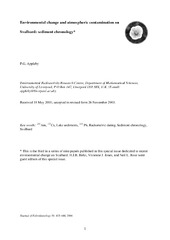Environmental change and atmospheric contamination on Svalbard: sediment chronology
Peer reviewed, Journal article
Permanent lenke
https://hdl.handle.net/1956/2478Utgivelsesdato
2004Metadata
Vis full innførselSamlinger
Originalversjon
https://doi.org/10.1023/b:jopl.0000022545.73163.edSammendrag
Sediment cores collected from eight lakes along the western coast of Svalbard as part of a project investigating atmospheric pollution and environmental change in Arctic regions were dated radiometrically using natural (210Pb) and artificial (137Cs and 241Am) fallout radionuclides. At four sites the sedimentation rates were relatively uniform, and in consequence the 210Pb dates were relatively unambiguous. At the remaining sites there were irregularities in the 210Pb activity versus depth profiles, indicating significant variations in the net sediment accumulation rate during the past 120 years. At these sites there were significant differences between 210Pb dates calculated using the two standard simple dating models (CRS and CIC). In most cases, stratigraphic dates based on the 137Cs and 241Am records supported use of the CRS model, though at one site (Ossian Sarsfjellet) the CIC model appeared more appropriate. The irregularities in the 210Pb records were mainly caused by episodes of accelerated sedimentation due, for example, to inwash or slump events, though at some sites there appears to have been a systematic increase in sediment accumulation rates in recent decades. Sediment accumulation rates were generally lower at the northern sites, and higher at the more southerly locations. Mean sediment accumulation rates varied by an order of magnitude, ranging from 0.002 - 0.050 g cm-2 y-1 (0.02 – 0.10 cm y-1). 210Pb fluxes measured from the core inventories were mostly in the range 34 - 80 Bq m-2 y-1 typical of Arctic sites. Much higher values, recorded at two sites (Birgervatnet and Daltjørna), may be due to significant inputs from in the catchments during spring thaw.
Beskrivelse
This is the third in a series of nine papers published in this special issue dedicated to recent environmental change on Svalbard. H.J.B. Birks, Vivienne J. Jones, and Neil L. Rose were guest editors of this special issue.
